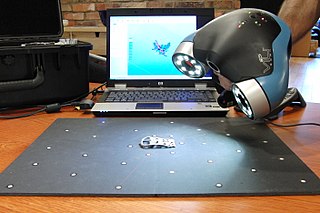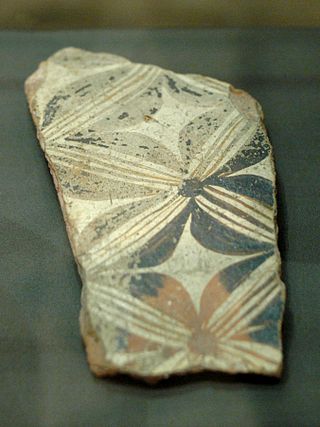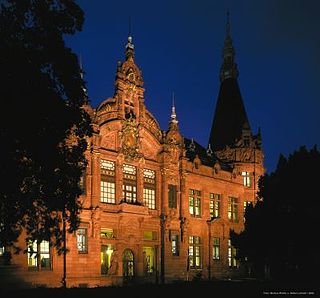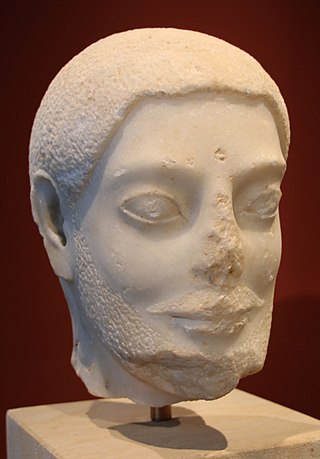
A digital elevation model (DEM) or digital surface model (DSM) is a 3D computer graphics representation of elevation data to represent terrain or overlaying objects, commonly of a planet, moon, or asteroid. A "global DEM" refers to a discrete global grid. DEMs are used often in geographic information systems (GIS), and are the most common basis for digitally produced relief maps. A digital terrain model (DTM) represents specifically the ground surface while DEM and DSM may represent tree top canopy or building roofs.
Computational archaeology describes computer-based analytical methods for the study of long-term human behaviour and behavioural evolution. As with other sub-disciplines that have prefixed 'computational' to their name, the term is reserved for methods that could not realistically be performed without the aid of a computer.

Cuneiform is a logo-syllabic writing system that was used to write several languages of the Ancient Near East. The script was in active use from the early Bronze Age until the beginning of the Common Era. Cuneiform scripts are marked by and named for the characteristic wedge-shaped impressions which form their signs. Cuneiform is the earliest known writing system and was originally developed to write the Sumerian language of southern Mesopotamia.

Scientific visualization is an interdisciplinary branch of science concerned with the visualization of scientific phenomena. It is also considered a subset of computer graphics, a branch of computer science. The purpose of scientific visualization is to graphically illustrate scientific data to enable scientists to understand, illustrate, and glean insight from their data. Research into how people read and misread various types of visualizations is helping to determine what types and features of visualizations are most understandable and effective in conveying information.

Assyriology, also known as Cuneiform studies or Ancient Near East studies, is the archaeological, anthropological, historical, and linguistic study of the cultures that used cuneiform writing. The field covers Pre Dynastic Mesopotamia, Sumer, the early Sumero-Akkadian city-states, the Akkadian Empire, Ebla, the Akkadian and Imperial Aramaic speaking states of Assyria, Babylonia and the Sealand Dynasty, the migrant foreign dynasties of southern Mesopotamia, including the Gutians, Amorites, Kassites, Arameans, Suteans and Chaldeans. Assyriology can be included to cover Neolithic pre-Dynastic cultures dating to as far back as 8000 BC, to the Islamic Conquest of the 7th century AD, so the topic is significantly wider than that implied by the root "Assyria".

In scientific visualization and computer graphics, volume rendering is a set of techniques used to display a 2D projection of a 3D discretely sampled data set, typically a 3D scalar field.

An aryballos was a small spherical or globular flask with a narrow neck used in Ancient Greece. It was used to contain perfume or oil, and is often depicted in vase paintings being used by athletes during bathing. In these depictions, the vessel is at times attached by a strap to the athlete's wrist, or hung by a strap from a peg on the wall.

In radiography, X-ray microtomography uses X-rays to create cross-sections of a physical object that can be used to recreate a virtual model without destroying the original object. It is similar to tomography and X-ray computed tomography. The prefix micro- is used to indicate that the pixel sizes of the cross-sections are in the micrometre range. These pixel sizes have also resulted in creation of its synonyms high-resolution X-ray tomography, micro-computed tomography, and similar terms. Sometimes the terms high-resolution computed tomography (HRCT) and micro-CT are differentiated, but in other cases the term high-resolution micro-CT is used. Virtually all tomography today is computed tomography.

3D scanning is the process of analyzing a real-world object or environment to collect three dimensional data of its shape and possibly its appearance. The collected data can then be used to construct digital 3D models.
Eurographics is a Europe-wide professional computer graphics association. The association supports its members in advancing the state of the art in computer graphics and related fields such as multimedia, scientific visualization and human–computer interaction.

Corpus Vasorum Antiquorum is an international research project for documentation of ancient ceramics. Its original ideal target content: any ceramic from any ancient location during any archaeological period, proved impossible of realization and was soon restricted to specific times and periods. As the project expanded from an original six nations: England, Belgium, Denmark, France, the Netherlands, and Italy, to include the current 28, the topic specializations of each country were left up to the commission for that country. The French commission, serves in an advisory position.
In 3D computer graphics, Potentially Visible Sets are used to accelerate the rendering of 3D environments. They are a form of occlusion culling, whereby a candidate set of potentially visible polygons are pre-computed, then indexed at run-time in order to quickly obtain an estimate of the visible geometry. The term PVS is sometimes used to refer to any occlusion culling algorithm, although in almost all the literature, it is used to refer specifically to occlusion culling algorithms that pre-compute visible sets and associate these sets with regions in space. In order to make this association, the camera's view-space is typically subdivided into regions and a PVS is computed for each region.

The Interdisciplinary Center for Scientific Computing is a scientific research institute of the Heidelberg University, Germany. It centralizes scientific activity and promotes research and work in scientific computing. Founded in 1987 by the Heidelberg University and the state of Baden-Württemberg, IWR participates in joint project and cooperations with industry in Germany as well as abroad. As a research institute with about 380 staff, IWR is considered one of the world's largest research centers for scientific computing.

The Heidelberg University Library is the central library of the Heidelberg University. Together with the 83 decentralized libraries of the faculties and institutes, it forms the University Library System, which is headed by the director of the University Library. The University Library holds special collections in literature concerning the Palatinate and Baden, egyptology, archeology, the history of art, and South Asia. It holds about 3.2 million books, 6,000 printed scientific periodicals, and about 500,000 other media such as microfilms and video tapes. The libraries of the faculties and institutes hold another 3 million printed books. In 2022, the University Library registered 43,600 active users who accessed more than 746,000 books. The conventional book supply is complemented by numerous electronic services, including approximately 152,00 electronic journals. The University Library provides around 1,100 reading- and workspaces in the main library in the old town and around 320 reading- and workspaces in the branch in the Neuenheimer Feld, including many IT-workstations and research stations equipped with PCs.
Polynomial texture mapping (PTM), also known as Reflectance Transformation Imaging (RTI), is a technique of imaging and interactively displaying objects under varying lighting conditions to reveal surface phenomena. The data acquisition method is Single Camera Multi Light (SCML).

A digital outcrop model (DOM), also called a virtual outcrop model, is a digital 3D representation of the outcrop surface, mostly in a form of textured polygon mesh.

Amira is a software platform for visualization, processing, and analysis of 3D and 4D data. It is being actively developed by Thermo Fisher Scientific in collaboration with the Zuse Institute Berlin (ZIB), and commercially distributed by Thermo Fisher Scientific — together with its sister software Avizo.

The Sabouroff head is a Late Archaic Greek marble sculpture. It is dated to c. 550–525 BC. This head of a Kouros was named after Peter Alexandrovich Saburov, a collector of ancient Greek sculpture and antiquities. It is 23 centimeters in height. The sculpture is currently located in the Antikensammlung Berlin and allegedly from Attica or Aegina. There are conjectures that it may also have been from Caria in Asia Minor.

Hubert Mara is an Austrian Computer Scientist who specializes in Archaeoinformatics and the application of methods from computer science to the humanities, and thus a combination of these fields.
















